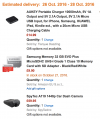a bit of warning regarding power bank: make sure you put it in the coolest place in the car (preferably in fireproof enclosure). Otherwise you might come back and your Porsche will be a pile of smoldering slag.
As I've related on these forums, my old Buick burned up as I watched. Inside it was a LiIon flashlight in the center console and I had it in full view throughout the event. It was already a hot summer day and it was about 6 minutes after the fire reached the console area before the light blew, flying out the open driver's door venting with flames. And another flashlight nut like myself tested heat vs LiIon with a gas torch with approximately similar results. There have also been reports from folks who store LiIon lights in their cars in Australia curing the summer without any signs of trouble. I've also not seen more then a few reports where LiIon cells experiencing the heat levels possible in a car vented, and that low percentage coincides with their overall catastrophic failure rate in normal circumstances. Therefore I and many others who use LiIon cells regularly have concluded that they are as safe to store and use in a car as they are in a house.
What
will happen is their lifespan will be shortened and the higher the heat the more significant this is. Estimates of as much as 70% loss have been noted though the usual rarely exceeds 50% loss. According one's usage this could take a year or three to become a problem. The most important external factor here is cell quality, which also significantly affects cell life overall. Good cells like Panasonic, LG, Samsumg, and Sanyo last longer, perform better, and are safer. Cheap LiIon cells should be avoided like the plague. That Aukey powerbank will probably have good cells in it. Most of the catastrophic LiIon cell failures occur during charging and the cheap powerbanks have not only cheap cells but often poorly regulated charging too.
Much of the online LiIon references are either somewhat or very outdated, and much of what is said about LiIon's is urban legend which has been retold so many times that almost everyone now believes it. Today's good cells use much better components inside and are far more robust than the earlier ones. Now that the process of thermal runaway is better understood it is better protected against during manufacture and there are far fewer instances of venting with flames versus a cell simply venting or failing otherwise. It still makes sense to not expose LiIon cells to excessive heat but more for reasons of lifespan than for safety.
It still needs to be borne in mind that this is a powerful technology unlike any other and that there is going to be a very small percentage of catastrophic failures which cannot be detected by QC or predicted. You're more likely to be struck by lightning twice in one day than have a good cell which has not been abused vent with flames but it does happen on the rare occasion. If this small risk factor is too much for you then get a powerbank which uses one of the LiPo battery technologies instead. Those are considerably safer but do not pack as much energy per volume so an equal unit will be bigger. They will also cost more too.
tldr: You're almost certainly safe to use a good quality LiIon powerbank in your car as long as you don't place it where it will receive excessive heat such as near heater vents, near hot exhaust system components, or in direct sunlight. Never use cheap LiIon cells or powerbanks- the foregoing does not apply to them.
Phil




